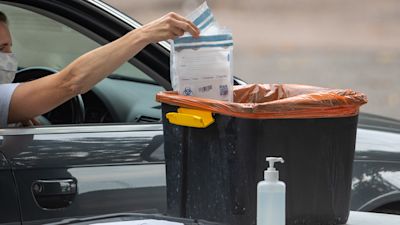Robert Peston: How to understand the trebling in Covid cases

The dramatic jump in UK coronavirus cases from 7,000 reported on Friday, to just under 13,000 on Saturday to a fraction below 23,000 on Sunday is not a dire as it seems - though it is NOT good news.What has inflated the numbers for Sunday and Saturday are a staggering 15,841 cases where the specimens were taken between 25 September and 2 October.
In other words there was a serious lag between the swab being taken and the result appearing in the government's official figures.The reason for the confidence-destroying lag is there was a glitch in two of Public Health England's "legacy" computer systems, which meant that data was not being transmitted properly. Or at least that is what a senior official tells me.The glitch has apparently now been fixed.But confusion has been sown and damage done.
New coronavirus rules: Has Boris Johnson done enough or too much?
How do we avoid another coronavirus lockdown? asks Robert Peston
For the avoidance of doubt, there has not been a trebling of infections in just two days. If the results are attributed by specimen date, the trend is roughly unchanged from what it had been in the previous couple of weeks, namely a doubling of infections roughly every nine days.The disappointment is that, until the missing infections turned up, it looked as though the rate of increase was flattening. That flattening has turned out to be a mirage.Also, if the trends are examined on a regional basis, the bad news is that the North West, North East and Yorkshire seem to be seeing worsening rates of infection relative to the rest of the country - even though they are subject to tighter behavioural restrictions and already suffer from greater viral prevalence.
On a more granular level, it is also conspicuous that the rate of increase is massively faster in university towns, from Exeter to Newcastle.Which is sort of good news, because - as a member of the government says - the infection is still most prevalent in younger people who tend to become less ill than older people.But it poses a massive policy dilemma for the prime minister and the health secretary, namely should they totally prohibit university students from travelling more than a few hundred yards from their halls of residence and rented rooms?The point is that the greatest danger now is that students seed the virus in the rest of the population - at which point the surge in infections would lead to a surge in acute illness, hospitalisations and deaths.
UPDATE: The other other disturbing consequence of almost 16,000 infections being reported late is that the majority of the infected people’s contacts were told by Test and Trace two days or more later than normal that they may have the virus.
Which means potentially infected people were not quarantined for at least a couple of days and the infection may have been seeding more widely as a result. Which is worrying, as I mentioned - and is also at odds with Test and Trace’s initial diagnosis of the computer glitch 24 hours earlier.